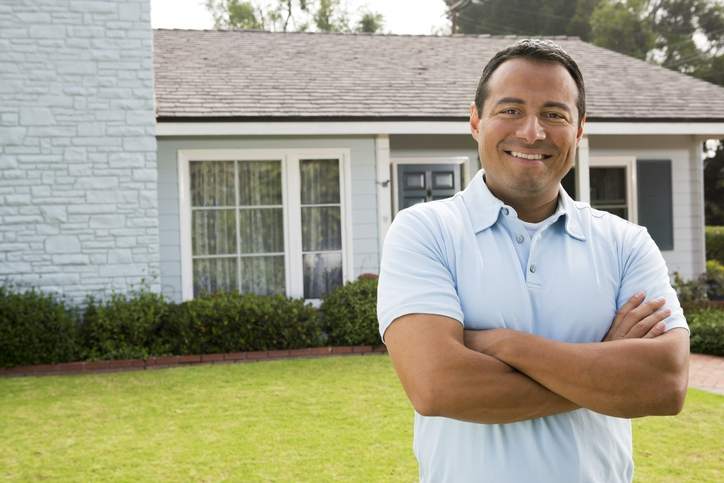For most homeowners, the monthly mortgage payment is the biggest line item in their budget. When that budget gets tight, homeowners often turn to a mortgage refinance to lower their interest rate and monthly payment, to borrow some of their home equity, or to change their loan term.
The refinancing process usually is similar to getting a primary mortgage. Borrowers need to document their income, go through a credit check, get a new appraisal, and pay closing costs. But qualified homeowners with a Federal Housing Administration mortgage can take advantage of an FHA streamline refinance to make the process simpler and easier.
Here’s what you need to know about refinancing with the FHA through this program.
Key Takeaways:
- The two types of FHA streamline programs are credit qualifying and noncredit qualifying.
- There are different costs associated with an FHA streamline refinance, including loan origination fees, title fees, and recording fees.
- Some benefits of FHA streamline refinances include quick closing times compared to conventional refinances, and the option to refinance with no home equity. Some drawbacks are that you can’t cash out more than $500, and this program is only available to FHA loan borrowers.
What Is an FHA Streamline Refinance?
The FHA helps Americans buy homes by insuring mortgages issued by private lenders. If the borrower defaults, the FHA covers the lender’s losses. This reduces the lender’s risk and serves as encouragement for lenders to offer more loans.
For homeowners with an FHA mortgage, a streamline refinance requires less paperwork documenting income and finances than a refinance to a conventional loan. FHA loans also don’t require a new home appraisal, which typically costs between $300 and $600.
The streamline refinance process gives FHA mortgage holders a simple way to reduce the interest rate on their mortgage, extend or shorten their loan term, and save money on their monthly payment. The trade-off comes in the form of greater limits on a streamline refinance when compared with a conventional refinance.
FHA streamline refinance vs. conventional refinance
The primary difference between an FHA streamline refinance and a conventional refinance is the amount of paperwork required. The FHA streamline refinance program, as its name suggests, streamlines the process by eliminating the need for a new appraisal, and by allowing borrowers to forgo some documentation of their income, employment, and other financial details.
A streamline refinance also limits homeowners to borrowing no more than $500 in equity, which is the difference between the current value of the home and how much is still owed on the mortgage.
With a conventional refinance, you could borrow all but 10% of the equity in your home — and sometimes even more, depending on the lender. That could easily total tens of thousands of dollars, which would be repaid at relatively low interest rates as part of your new mortgage. The money from a cash-out refinance can be used for anything, but most homeowners use their equity to improve their long-term finances by paying for home improvements or education costs, or by consolidating debts.
To qualify for a streamline refinance, borrowers must already have an FHA mortgage. Here’s a breakdown of the differences between an FHA streamline refinance and a conventional refinance:
FHA Streamline Refinance vs. Conventional Refinance
| FHA Streamline Refinance | Conventional Refinance |
| Only available to borrowers who have an existing FHA loan. | Can be used to refinance almost any mortgage. |
| Less documentation required. | The lender will need several documents, including W-2 forms, tax returns, pay stubs, bank statements, and proof of insurance. |
| No income, credit, or employment requirements. | Likely requires a debt-to-income ratio of 43% or lower. |
| Can refinance with no home equity. | At least 20% equity usually needed to refinance. |
| Can only cash out $500 in equity. | The maximum amount lenders typically allow you to cash out is 80% to 90% of your equity. |
FHA streamline refinance vs. FHA cash-out refinance
Although FHA streamline refinances and FHA cash-out refinances both are insured by the FHA, there are key differences.
An FHA streamline refinance focuses on making your existing FHA mortgage more affordable by allowing qualified borrowers to adjust their rate and term. The credit requirements and underwriting process for an FHA streamline refinance are limited, and you can’t cash out more than $500 in equity.
If you want to cash out more than $500 in equity, then one option is an FHA cash-out refinance. An FHA cash-out refinance isn’t just for borrowers who already have an FHA loan. Qualified borrowers can use this loan to refinance other types of mortgages as well — such as a conventional loan. However, because you can borrow up to 80% of your equity with an FHA cash-out refinance, there are stricter requirements, and the underwriting process is more rigorous. Here’s a summary of the differences between an FHA streamline refinance and an FHA cash-out refinance:
FHA Streamline Refinance vs. FHA Cash-Out Refinance
| FHA Streamline Refinance | FHA Cash-Out Refinance |
| Only available to borrowers who have an FHA loan. | Can be used to refinance a variety of loan types. |
| Can only cash out $500 or less in equity. | Can cash out up to 80% of the home’s equity. |
| No credit check required. | Must have a minimum credit score of 500, and some lenders may have additional requirements. |
| Doesn’t require a new home appraisal. | Must verify the value of your home with a refinance appraisal. |
Types of FHA streamline programs
There are two primary types of FHA streamline loans: credit qualifying and noncredit qualifying.
Credit qualifying
A credit-qualifying FHA streamline refinance involves the lender verifying the borrower’s financial information to be sure that they are capable of repaying the loan. The lender confirms the borrower’s income and credit score, calculates their DTI ratio, and makes sure the borrower can afford their mortgage payment. It’s a similar process to applying for a mortgage when buying a home.
Credit-qualifying FHA streamline refinances are used when refinancing will increase the monthly payment on the loan by more than 20%, or when it will cause other major changes to the loan’s terms.
Borrowers with good credit also are more likely to get lower interest rates or other favorable terms with a credit-qualifying loan.
Noncredit qualifying
With a noncredit-qualifying FHA streamline refinance, borrowers don’t need to provide income and credit information, and lenders don’t need to verify whether the borrower can afford to keep paying their mortgage.
One of the main drawbacks of a noncredit-qualifying refinance is that the borrower might not be eligible to reduce their interest rate as much as they could with a credit-qualifying refinance. You may choose a noncredit-qualifying refinance if your credit score has dropped, or if you don’t meet income or employment requirements for a credit-qualifying refinance.
FHA Streamline Requirements
To qualify for an FHA streamline refinance, borrowers must meet these requirements:
- The loan to be refinanced must be insured by the FHA. For example, borrowers who have a conventional mortgage or a loan backed by Veterans Affairs or the U.S. Department of Agriculture can’t use an FHA streamline refinance.
- The borrower must not be delinquent on the loan. The borrower can’t have more than one 30-day late payment in the past six months. Additionally, borrowers must be caught up on the last six months of mortgage payments.
- The borrower needs to meet seasoning requirements. At least six months need to have passed since the borrower took out the FHA loan, and at least 210 days need to have passed since the closing date. Borrowers also need to have made at least six mortgage payments on the loan.
- The refinance must create a tangible benefit for the borrower. A tangible benefit can be a lower mortgage interest rate, a shorter loan term, or switching from an adjustable-rate mortgage to a fixed-rate mortgage.
- The borrower must be refinancing an eligible property type. Borrowers can refinance one-to-four-unit primary residences, secondary residences approved by the Department of Housing and Urban Development, and investment properties.
Keep in mind that lenders might have additional requirements, such as credit score minimums.
Lenders have the flexibility to offer streamline refinances in many ways, so long as borrowers meet their requirements. For example, some lenders may offer refinancing with no closing costs, but charge a higher interest rate instead.
Documents required for an FHA streamline refinance
One of the benefits of an FHA streamline refinance is that it has simpler documentation requirements. Still, borrowers will need to provide several documents to refinance, including:
- An FHA mortgage note.
- A deed of trust.
- Two months’ worth of bank statements.
- A current mortgage statement.
If you use a credit-qualifying FHA streamline refinance, you may need to provide more documents.
FHA Streamline Refinance Costs
Refinancing a loan costs money, and an FHA streamline refinance is no different. Lenders are free to charge typical closing costs for an FHA streamline refinance, including:
- Loan origination fees.
- Prepaid property taxes.
- Title fees.
- Recording fees.
You’ll also have to pay for FHA mortgage insurance premiums if the FHA loan you’re refinancing was taken out after May 31, 2009. There are both upfront and ongoing components to MIP:
- Upfront MIP: This payment is equal to 1.75% of the amount you borrow, or the mortgage principal. For example, if you get a $250,000 loan, you’ll pay $4,375 upfront.
- Annual MIP: You’ll make ongoing MIP payments, which most lenders add to your monthly mortgage payment. The amount you pay depends on the term of your loan, the loan balance, and your loan-to-value ratio.
Pros and Cons of an FHA Streamline Refinance
Financial decisions come with pros and cons. Here’s a summary of the benefits and drawbacks of an FHA streamline refinance:
Pros vs. Cons of an FHA Streamline Refinance
| Benefits | Drawbacks |
| Limited documentation requirements. | Only FHA loan borrowers are eligible. |
| Can make your mortgage more affordable. | You may not qualify if you don’t meet seasoning requirements. |
| Can refinance with no equity. | It’s not possible to cash out more than $500 in equity. |
| A new home appraisal isn’t required. | Must be current on your FHA loan payments. |
| Quick closing time. | Refinancing closing costs. |
| Option for an MIP refund. | MIP costs. |
Benefits of an FHA streamline refinance
There are advantages to getting an FHA streamline refinance, including:
- Reduced documentation requirements. FHA streamline refinancing requires less documentation than conventional refinancing.
- Less time needed to close. The reduced underwriting requirements mean a faster closing time.
- Borrowers can refinance with no equity. Because a new home appraisal isn’t required, you can use an FHA streamline refinance even if you haven’t built any equity.
- The ability to adjust your loan terms. Streamline refinancing can reduce your interest rate or monthly payment, allow you to change between an ARM and a fixed-rate mortgage, and adjust your loan term.
- A mortgage insurance premium refund. FHA mortgages require borrowers to pay MIP. When you get an FHA streamline refinance, some of the upfront MIP paid on your original loan can be refunded. If you refinance within five years of getting your original loan, you could recoup as much as 97.5% of your upfront MIP payment.
Drawbacks of an FHA streamline refinance
Streamline refinancing isn’t perfect, so it’s important to know the disadvantages:
- Only FHA borrowers are eligible. If your current mortgage is not an FHA loan, you can’t get an FHA streamline refinance.
- You have to pay MIP. While you may receive a refund for some of the upfront MIP you paid to get your original loan, your new FHA streamline loan also will require an upfront MIP payment, as well as ongoing MIP payments. The upfront MIP is equal to 1.75% of the amount borrowed, so you’ll have to pay $1,750 for every $100,000 you’re refinancing.
- There’s a limit on how much cash you can take out. FHA streamline refinances only allow borrowers to cash out $500 in equity from their home. If you’re looking to borrow cash for a major expense, you’ll need another refinance option.
- If you’re struggling to make payments, you may not qualify. While this type of refinance can make your FHA loan more affordable, you won’t qualify unless you’re current on payments.
Is an FHA Streamline Refinance Right for You?
Whether an FHA streamline refinance is right for you will depend on your specific situation and goals.
FHA streamline refinancing is simpler than getting a conventional refinance loan. It’s possible to qualify even if you have poor credit, making it a good choice for borrowers who might not be able to refinance otherwise.
Streamline refinancing also could help you save money by lowering your loan’s interest rate. Extending your loan term could lower your monthly payment as well, and give you more breathing room in your budget.
However, FHA streamline refinances require borrowers to pay for MIP, and limit the amount of home equity you can borrow to $500. You’re also required to have an existing FHA loan.
“An FHA streamline refinance is an excellent option for homeowners with existing FHA loans,” says Josh Steppling, a real estate broker associate at eXp Realty in Stuart, Florida. “It’s designed to make the refinancing process quicker and more straightforward, with reduced documentation and lower closing costs. Homeowners with FHA loans who want to lower their interest rate or monthly payments should consider it.”
If you want to refinance your FHA loan, an FHA streamline refinance might be right for you if:
- Your income has decreased.
- You don’t have much equity built up.
- Your home has depreciated in value.
- Interest rates have decreased.
- You want to adjust your loan term.
- You’re current on payments, but you still want to make your monthly payments more affordable.
FHA Streamline Refinance FAQ
Here are answers to some frequently asked questions about FHA streamline refinances.
You can use an FHA streamline refinance even if you have no home equity because an appraisal isn’t required.
With an FHA streamline refinance, there’s a limit to how long you can extend your loan term, or the maximum amortization period. The limit is the lesser of: the remaining term of your existing FHA loan plus 12 years, or 30 years.
One way to remove MIP is to refinance to a mortgage that isn’t insured by the FHA. Otherwise, the rules regarding how you can cancel MIP depend on when your loan was originated.
If your FHA loan was originated after June 3, 2013, you’ll need to have made a 10% down payment on the loan and have made on-time payments for the last 11 years to cancel MIP. For loans originated before June 3, 2013, you’ll need to have made on-time payments for the last five years and have a 78% LTV ratio.
Comparing FHA streamline refinance lenders is just like comparing lenders for other types of mortgages. Reach out to multiple lenders to get a quote on interest rates, ask the lender questions, and don’t forget to factor in the lender’s reputation and customer service. Choose the refinance lender that will work best for you and your situation.
The Bottom Line on FHA Streamline Refinancing
FHA streamline refinancing could be a helpful option for homeowners who want an easy way to refinance their FHA loan. It does lack some of the features of a conventional refinance, which may be a better choice for people who have built significant equity and have good credit scores. But the limited paperwork requirements and optional credit check of a streamline refinance could save time and money for homeowners with an FHA mortgage.
More From LowerMyBills:
- USDA Mortgage Refinancing Guide: What You Need To Know
- Refinancing Your VA Loan: Requirements and Benefits
- How To Refinance a Jumbo Loan
- Refinancing a Home Equity Loan: Is It Possible?
- How To Refinance a Mortgage When You’re Self-Employed
- Refinancing Before, During, or After a Divorce: What To Know






